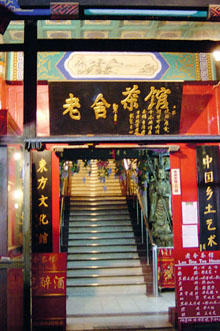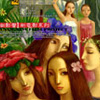The many faces of a Beijing teahouse
Updated: 2007-01-12 09:18
 Drinking tea is an ancient culture of China and teahouses happen to be as old as the production of tea. Developed throughout China from as early as the Tang Dynasty (618-907), visiting a teahouse had become common practice by the time the Qing Dynasty (1644-1911) arrived. Teahouses of all sizes and statures had made the tea culture live among the hearts of every citizen. Even dancers, singers and magicians were brought in to cheer up the visitors, and that tradition still stands today.
Drinking tea is an ancient culture of China and teahouses happen to be as old as the production of tea. Developed throughout China from as early as the Tang Dynasty (618-907), visiting a teahouse had become common practice by the time the Qing Dynasty (1644-1911) arrived. Teahouses of all sizes and statures had made the tea culture live among the hearts of every citizen. Even dancers, singers and magicians were brought in to cheer up the visitors, and that tradition still stands today.
We had a unique experience of China's culture and tradition on our visit to the much-acclaimed "Lao-she" teahouse in Beijing. Located to the west of the Qianmen Gate on the southern edge of Tian'anmen Square, the teahouse is named after the famous Chinese novelist and playwright, Lao She, and his masterpiece drama "Teahouse."
Decorated and furnished in the Qing Dynasty style with lanterns hanging from the ceiling and traditional Chinese paintings and calligraphy displayed on the walls, the stage was already set for the much-acclaimed entertainments that were yet to start. The teahouse was also the place for fans of Beijing folk art. Traditional Chinese arts such as painting, sculpture, antiques, kites and jades were on sale, giving a glimpse of the heritage of Chinese culture.
We took our seat quite near to the stage; we could choose how close to the stage we sit, depending on the entry fee we paid. Our table was set with porcelain tea cups and after a while traditional snacks were being served. Tea was of course the major draw but we also received handsome helpings of dried plums, pastries, steamed buns, dried mango and watermelon seeds served on our table. The snacks were all prepared according to ancient recipes from the imperial kitchen. The tea was being refilled every time we took gracious sips from the ethnic saucers and we felt as if we were in an ancient setting of Beijing, drinking the best brews in China. The most interesting fact was the serving of tea by a highly acrobatic waiter, who was constantly active to make sure our cup was never empty and all this, amazingly, achieved from a great height!
The show started at its usual time. An electronic display board at one side of the stage had subtitles of the songs in English. The usual an chor-ing was of course done in English.
The teahouse was gradually transformed into a wonderful entertainment house with skits and shows by comedians, singers, musicians and magicians. We kept munching on the mouthwatering snacks and kept watching the cultural shows with great enthusiasm while our cups were kept re-filled with extreme agility.
The best part of a show is always preserved for the last, and it was no different here.
It started with an acrobatic show where two young girls showed amazing acrobatic
acts with glasses, fans and even fire lit lamps. It was an absolutely magnificent show. The body movement of the artists would make you think that perhaps there were no bones in their body; such was the flexibility and the elasticity of their limbs.
Secondly was the Shaolin Temple martial arts; an art which is admired and awed by the entire world. Artists dressed up as Shaolin monks displayed "Wu Shu," the Chinese name for Shaolin kungfu, literally meaning practical boxing. Since the purpose of kung-fu was to repel threats from anti-social elements, the high priests of the Shaolin Temple had devised power - ful techn iques like breaking through a wall or walking on the surface of water. For us, we got to see what pure art it really was. The artistes displayed amazing martial arts by breaking piles of bricks with a stroke of their palm, and even breaking an iron scale into two halves by just hitting it straight on the forehead. Loud applause followed after every such unbelievable "act."
The final and perhaps the best among the entire show was the Peking opera face change. Face changing is the highlight of the Opera and it is said that ancient people painted their faces to drive away wild animals. Peking Opera has absorbed this ancient skill and perfected it into an amazing art. We were glad of being a part of this skill! Face changing indeed was a magical art and we got to see the most complicated part, the pulling mask routine. Here masks are painted on pieces of damask, each well trimmed. Hung with a superfine thread, the masks are then lightly pasted on the face in layers. The thread is controlled in an invisible manner from within the costume by certain gestures of the artist. The masks then change one by one and the excitement is just too much. For us, as long as the artist was on the stage, it was a swish of the cloak that changed the mask. Later, when the performer came down to shake hands with the audience, the mask changed with just a friendly nod as the hands of the performer and the audience touched. The colours changed from green to blue, from red to yellow and from various other combinations with different facial expressions, making every one in the audience ecstatic about shaking hands with the artist. The last step was when the original face of the artist was shown and it was revealed that she was... a lady! The loud applause went on even after the curtains had been drawn. Nothing else would match the excitement of this item and our child was overwhelmed and decided to preserve her hand carefully, which she shook with the lady.
The show was over and it was time for us to return. The teahouse experience had truly given us a wide idea of China's ancient culture.
Since its opening, Lao She Teahouse has entertained many famous people from China and all over the world, including former US president George Bush Sr. Autographed photos of all the dignitaries who have visited the teahouse are ceremoniously displayed on the walls, and its idea of showcasing the traditions of China in such a unique manner has probably made it a "must see" while in Beijing.
Laoshe Teahouse
Location: Building No.3, Zhengyang Market, Qianmen Xidajie
Tel: 010-63036506
|
||
|
||
| Eating out:
Arriba arrives in the Wu
Bars&Cafes: Mare's milk a-go-go Weekend&Holiday: Ancient sites re-open after renovation Shopping: Jimmy Choo comes What's on: New shows on stage |
|
||
| Eating out:
Moroccan roll
Bars&Cafes: A boonna in training Weekend&Holiday: Pop power Shopping: LV boutique in E. China closed for disqualification What's on: Jazz-infused journey through Kunqu Opera |

